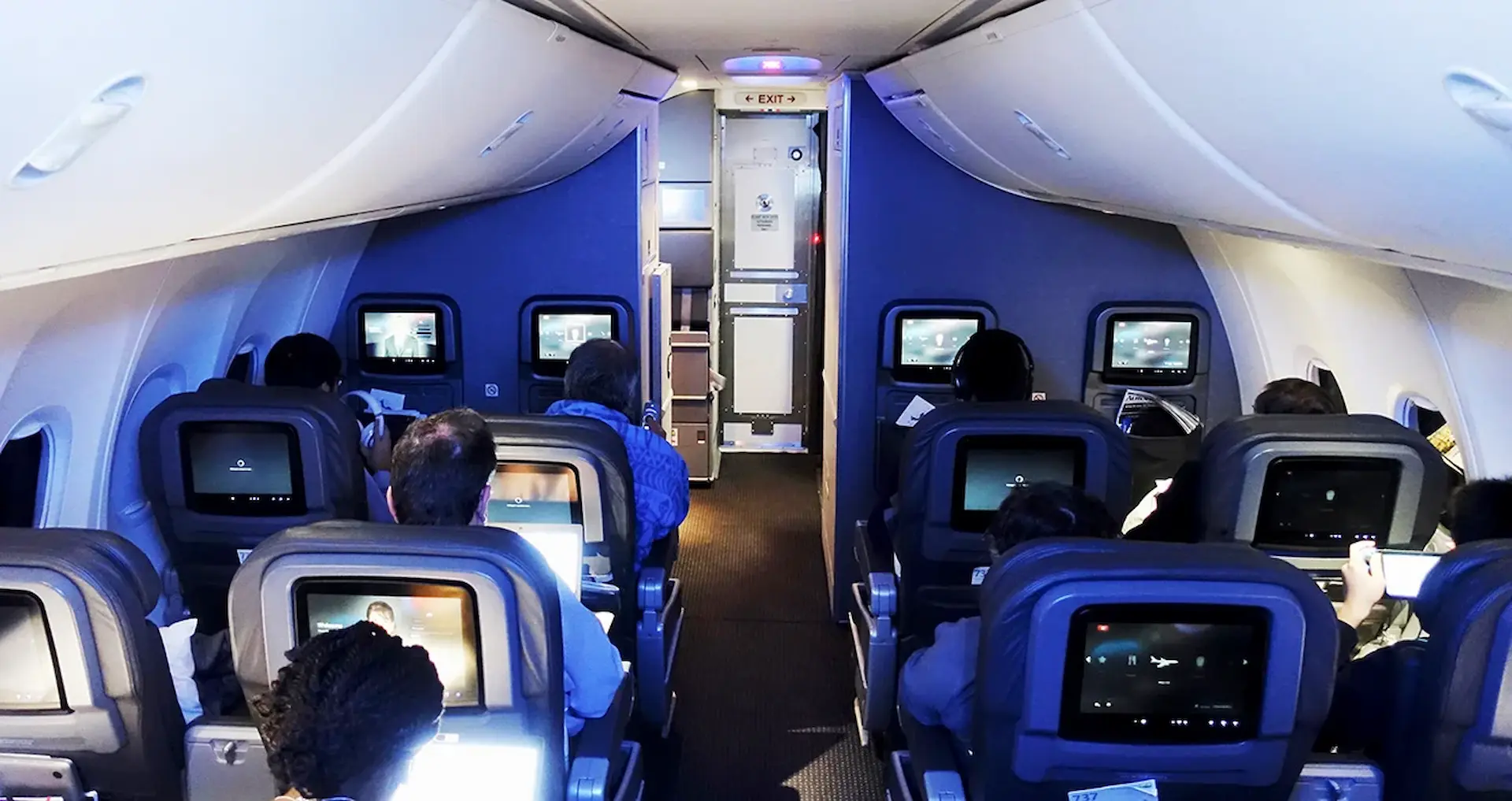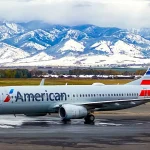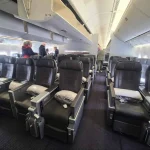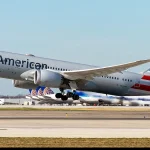Having flown on over 300 commercial flights in the U.S., I can confidently say that not all first class experiences are created equal, especially on domestic routes.
Flying First Class on a narrow-body aircraft like the Boeing 737-800 is a unique experience, especially when operated by one of the largest carriers in the world, American Airlines. I’ve flown this configuration more times than I can count, and every flight has added another layer to my understanding of what travelers can expect. Whether you’re a frequent flyer, a miles optimizer, or simply curious about what lies beyond the curtain, I’m breaking down every detail of this specific First Class experience.
Let me take you seat by seat, meal by meal, and service by service through American Airlines’ 737-800 First Class. This review blends first-hand experience with deep technical data, current fleet insights, and hard facts.
What is the Boeing 737-800 and How Does American Airlines Use It?
The Boeing 737-800 is one of the most widely operated aircraft models in the American Airlines fleet. As of 2024, American Airlines operates over 300 Boeing 737-800s, making it the backbone of their domestic operations.
This aircraft seats 160 passengers in total:
- 16 First Class
- 30 Main Cabin Extra
- 114 Main Cabin
It’s used primarily on high-frequency domestic routes, like Dallas to Los Angeles, Miami to Chicago, and New York to Tampa. Some shorter international flights to Mexico and the Caribbean also see this aircraft.
Most of American’s 737-800s are between 10 to 22 years old, but the interiors have been retrofitted with newer cabins as part of the “Oasis” redesign. That means a more uniform cabin, power at every seat, but less padding and narrower lavatories.
What to Expect from First Class on the Boeing 737-800?
How is the First Class Cabin Configured?
The First Class cabin is laid out in a 2-2 configuration across four rows, for a total of 16 seats. Unlike lie-flat seats on wide-body aircraft, these are recliner-style seats. Here’s what you get in terms of dimensions:
- Seat Pitch: 38 to 40 inches
- Seat Width: 20.5 inches
- Recline: About 5 to 6 inches
From experience, row 2 is the sweet spot. It’s far enough from the galley and bathroom but still gets meal preferences before row 4. Row 1 has more legroom but has fixed armrests due to tray tables and no under-seat storage.
How Comfortable Are the Seats?
The 737-800 first class seat is comfortable for short to medium-haul flights (1–4 hours), but don’t expect a lie-flat experience. The leather seats are wide enough for most body types, and I’ve found them more than adequate for daytime flying or evening hops.
However, the lack of footrest or enhanced recline may become noticeable on flights over 3 hours. Still, compared to Main Cabin Extra or economy, the extra space, wider seat, and dedicated cabin feel like a genuine upgrade.
Pro tip: Seat 4A or 4F offers a bit more privacy and tends to be quieter than the forward rows near the galley.
In-Flight Service in First Class
Service in first class on American’s 737-800 varies slightly by flight length but follows a consistent structure. Here’s what I typically receive on different routes:
900 Miles (Short-Haul)
- Pre-departure beverage (when staffing allows)
- Bottle of water
- Snack basket (chips, almonds, cookies)
- Alcoholic and non-alcoholic drinks
900–2,200 Miles (Mid-Haul)
- Full beverage service
- Hot towel (select routes)
- Meal service during key meal windows (breakfast, lunch, dinner)
- Choice of entrée (hot or cold, depending on flight time)
- Dessert, often a packaged cookie or brownie
2,200+ Miles (Transcon/Longer Domestic)
- Full plated meal (3-course style)
- Premium snacks and multiple drink rounds
- More attentive service pacing
The crews are generally professional, and service is quick due to the small cabin size. However,In my experience, the quality of meals is hit or miss. The presentation is solid, but flavor often falls behind. You’re not getting Flagship Dining here, it’s practical sustenance at 35,000 feet.
Wi-Fi and Entertainment: What’s Available?
There are no seatback screens on most 737-800 aircraft. Instead, American offers streaming entertainment via the AA app, which includes:
- Dozens of movies and shows
- Live TV on select routes
- Free access to Apple TV+ and HBO Max content
- Audio books and podcasts
Connectivity:
- Wi-Fi Provider: Gogo or ViaSat (depending on tail number)
- Wi-Fi Cost: ~$10–$19 per flight or monthly passes via AAdvantage
- Streaming Capability: Generally strong on ViaSat-equipped aircraft
If you rely on consistent entertainment, bring your own device preloaded with content, just in case.
How Does First Class Compare to Main Cabin and Main Cabin Extra?
| Feature | First Class | Main Cabin Extra | Main Cabin |
| Seat Pitch | 38–40 in | 34–36 in | 30–32 in |
| Seat Width | 20.5 in | 17.3 in | 17.3 in |
| Recline | 5–6 in | 2–3 in | 2 in |
| Power Outlets | Yes | Yes | Yes |
| Wi-Fi | Available | Available | Available |
| Complimentary Meals | Yes (select routes) | No | No |
| Free Alcohol | Yes | No | No |
| Baggage Allowance | 2 free bags | Paid | Paid |
| Boarding Group | Group 1 | Group 5 | Group 8–9 |
There’s a tangible upgrade in comfort when moving from Main Cabin to First Class, but it’s not transformative like a long-haul business class seat.
Which routes typically feature the 737-800 First Class?
The Boeing 737-800 operates across hundreds of routes in American’s network. You’ll find this aircraft on:
Common 737-800 First Class Routes:
- Dallas–Fort Worth (DFW) to Los Angeles (LAX) – 3h 10m
- Chicago (ORD) to Phoenix (PHX) – 3h 40m
- Miami (MIA) to New York (JFK) – 2h 50m
- Charlotte (CLT) to Denver (DEN) – 3h 25m
- Philadelphia (PHL) to Dallas (DFW) – 3h 20m
Even routes under two hours, like DFW–San Antonio, can sometimes feature the 737-800. But the sweet spot for this product is on 2–4 hour flights, where the extra comfort really makes a difference.
How Much Does a First Class Ticket Cost on a Boeing 737-800?
Price Range Examples (One-Way)
- Short haul (LAX–PHX): $250–$400
- Medium haul (DFW–ORD): $400–$700
- Long haul (MIA–SEA): $700–$1,000+
Pricing Factors
- Route demand: High-traffic airports command higher fares.
- Time of booking: Prices spike within 7 days of departure.
- Time of day: Red-eyes and midweek flights tend to be cheaper.
- Upgrade eligibility: Status members often get upgrades cleared closer to departure.
Dynamic pricing means First Class sometimes costs just $120 more than Main Cabin Extra. When it does, I almost always take the upgrade.
How does the onboard service compare to other domestic carriers?
American’s First Class service is above average, especially compared to low-cost carriers and even some legacy airlines. That said, it doesn’t match Delta’s consistency or Alaska’s service polish on every route.
What American does well:
- Fast boarding and early deplaning
- High drink service consistency
- Comfortable recliner seating
- Competitive catering on longer flights
What needs improvement:
- Lack of seatback entertainment
- Occasional inconsistency in cabin crew attentiveness
- Limited snack options on shorter flights
In my experience, service varies more by crew than by route. I’ve had attentive, friendly staff who offered refills unprompted, and I’ve had flights where I barely saw the FA after meal service. Still, it’s a far better experience than Main Cabin, even with its flaws.
Who Should Consider Booking First Class on a 737-800?
I usually recommend First Class in the following scenarios:
- Business travelers: The space, outlet access, and quiet environment are ideal for working.
- Mileage maximizers: If you have upgrade certificates or AAdvantage miles, short hops offer excellent redemption value.
- Older passengers or those with mobility needs: Priority boarding, wider seats, and proximity to lavatories help ease the travel experience.
- Anyone flying over 3 hours: The incremental cost may justify the added comfort and meals.
However, if you’re on a flight under 90 minutes, Main Cabin Extra often delivers 80% of the value for a fraction of the cost.
How does the First Class seat compare to other U.S. airlines?
Let’s compare American’s 737-800 First Class with similar cabins on Delta, United, and Alaska Airlines:
| Feature | American Airlines | Delta Air Lines | United Airlines | Alaska Airlines |
| Seat Pitch | 37–40 inches | 36–38 inches | 37 inches | 41 inches |
| Seat Width | 20.5 inches | 20.9 inches | 20.5 inches | 21 inches |
| Seatback IFE | No | Yes (select aircraft) | Yes (on most 737s) | No |
| Power Ports | Yes | Yes | Yes | Yes |
| Meals Over 900 Miles | Yes | Yes | Yes | Yes |
| Wi-Fi | Yes (Viasat/Gogo) | Yes (Delta Sync) | Yes (United Wi-Fi) | Yes |
Alaska has slightly more legroom, and Delta has better entertainment options. But American holds its own in terms of seat quality and onboard food offerings.
What do frequent flyers say about the 737-800 First Class?
I track frequent flyer forums like FlyerTalk and Reddit’s r/americanairlines closely, and I talk to fellow elites often. The sentiment around American’s 737-800 First Class is generally positive, but grounded.
Common praise:
- Solid seat comfort and personal space
- On-time performance and smooth boarding
- Meal improvements post-COVID
Common complaints:
- Inconsistent crew service
- No seatback screens
- Lack of true luxury feel (especially on shorter flights)
Overall, the expectation vs. reality gap is small. People know what they’re getting, and it usually meets or slightly exceeds expectations.
Expert Tips for Flying First Class on a 737-800
- Choose row 2 for the best balance of quiet and comfort
- Avoid row 4 if you don’t want to be near the lavatories
- Use AAdvantage miles for short-haul upgrades, great value
- Bring your own entertainment and headphones
- Book early flights for better catering and upgrade availability
If you value productivity, rest, and service, First Class is worth the upgrade, especially if you’re not paying full fare.
To keep essentials accessible during boarding and inflight, these best fanny packs for travel in 2025 are an easy, lightweight add-on.
How Can Travelers Upgrade to First Class on American Airlines?
Upgrades can be confirmed in several ways:
- AAdvantage Miles: Domestic upgrades start at 15,000 miles + $75.
- Systemwide Upgrades: Available for Executive Platinum members, useful on any route.
- Complimentary Upgrades: Gold and above get free upgrades on domestic routes (subject to availability).
- Paid Upgrades: Often offered at check-in or in the app, sometimes as low as $89.
For best results, book flights with upgrade-friendly fare classes (Y, B, H) and choose routes with multiple daily departures.
Is First Class on the 737-800 worth the upgrade?
Yes, if comfort matters to you. You’re paying for space, better service, and a bit of quiet. If you’re over 6 feet tall, trying to work inflight, or just value a less chaotic environment, the upgrade is worthwhile, especially on flights over 2 hours.
You can often upgrade using:
- AAdvantage miles (15,000 + $75 copay)
- Complimentary upgrades (for elite status holders)
- Same-day cash upgrades at check-in (often $150–$250)
Personally, I’ve never regretted upgrading on this aircraft. It’s not luxurious, but it’s reliable and better than Economy by a clear margin.
For a tighter same-aircraft comparison, the American Airlines Boeing 737-800 business class review adds extra perspective on the cabin experience.
FAQs About First Class on the 737-800
Are the seats lie-flat on the 737-800?
No. All seats are standard recliners, not lie-flat. This aircraft is for domestic and regional routes.
Is the cabin quiet?
It’s average for a narrow-body jet. The bulkhead and rear of first class are quieter than the galley zone.
Do all 737-800s have the same first class cabin?
Almost. American has standardized interiors during recent cabin refreshes, but you may find small differences in seat age or USB ports.
Can I upgrade with miles or status?
Yes. AAdvantage elite members can upgrade using miles, systemwide upgrades, or Loyalty Point thresholds.
Is lounge access included with a first class ticket?
Only on international routes. Domestic first class does not grant Admirals Club access unless you have elite status or a lounge membership.
If you’re weighing first class value across carriers, our United Airlines review helps you benchmark what you get for paying up.





